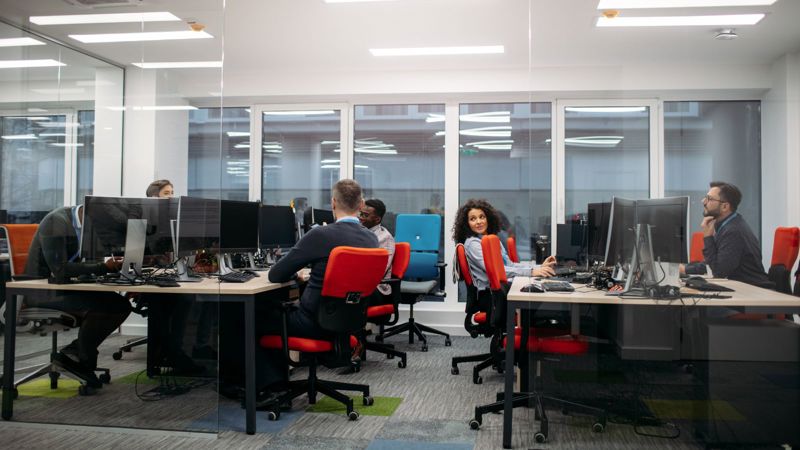Are open-plan offices a good idea? Hear the experts' verdict
Is it a blessing or a curse to sit next to your colleagues? Three experts list all pros and cons of landscaped offices.
Loud phone conversations and colleagues coughing. Many things may irritate you when working in landscaped offices with others. On the other hand, your colleagues are close by when you need help with something or simply need a laugh.
So what are the real advantages and disadvantages of open-plan offices? Three experts give us their opinion on the matter.
We’ll begin with the negative side.
The collegiate community environment disappears
Even if you would immediately think that the lack of walls and doors between colleagues facilitates conversation and fosters solidarity at the workplace, landscaped offices may quite often have the opposite effect, explains Helge Hvid, Emeritus Professor at the Centre for Research on Working Life at Roskilde University
He points out that it often becomes the norm to speak quietly or not speak at all in order not to disturb colleagues.
"Thus, the more spontaneous talk about the election, a football match or the like will be very limited. And that weakens the collegiate community environment," he says.

The spontaneous conversation in open-plan offices can often be limited because you don't want to disturb your colleagues, explains Helge Hvid, Emeritus Professor at the Centre for Research on Working Life at Roskilde University. Photo: Canva.
Sickness absence rate on the rise
As the cool autumn weather makes colleagues catch a cold, the question is whether the landscaped offices become a place where bacteria frolic across desks?
At any rate, research concludes that, among employees who work in open-plan offices, the number of sick days is higher than for those who work in their own office.
This is explained by Jan Hyld Pejtersen, senior researcher at Vive, who has carried out his own studies on the subject.
"If you are many people in one room, the sickness absence rate is higher than if you sit alone," he reports.
He emphasises that the studies do not show precisely why this is the case, but admits that a possible explanation could be employees infecting each other in the landscaped offices.
Noise and poor indoor climate
According to Jan Hyld Pejtersen, employees in open-plan offices are also to a greater extent faced with problems related to the indoor climate and poor air quality. And especially phones ringing and colleagues talking in loud voices are also a source of great irritation for employees who work together in large offices.
"There is a lot of noise, and people interrupt each other," Jan Hyld Pejtersen explains.
According to Helge Hvid, research also shows that although the indoor climate is objectively worse in the open-plan offices, complaints about the indoor climate actually have to do with other things.
"When the indoor climate bothers you, the real cause is that you are annoyed with the working environment in general," he says.

Interior design makes the difference
But are there only bad things to say about open-plan offices?
No, Eva Bjerrum claims. She is an organisational analyst at the Alexandra Institute and has made many observations of companies that use landscaped offices.
But in order for the open-plan offices to be a success, it is important that the interior design has been given careful thought so that it becomes more attractive than having your own office.
"There must be some open-plan environments where employees can talk to each other and where you are allowed to say good morning, discuss a matter at the desk or answer the phone. And then there has to be some kind of reading room to escape to if you need to concentrate," Eva Bjerrum says, explaining that it should be designed like a quiet compartment on the train, where phones are set to silent mode and no talking is allowed.
"You have to be unavailable in the same way as if you work at home," she says and emphasises that it is also necessary to create good environments for Teams meetings and meeting rooms for various types of meetings.
However, the physical framework does not do the trick on its own.
"It's also about having a workplace that supports a professional atmosphere; An atmosphere encouraging actual cross-disciplinary collaboration. And where your knowledge will benefit your colleagues," explains Eva Bjerrum.
Supporting work processes
If, however, the workplace succeeds in creating the optimum framework, there are obvious advantages to the open-plan offices.
"Then the advantages are that you have a physical setting to support your work processes. You have immediate access to each other, and you have a social and professional community," says Eva Bjerrum.
She underlines that a lot happens during a work day that you can benefit from and which you risk missing out on if you stay in your own office or work from home.
You might overhear colleagues at the desk next to you talking about a new project that you would like to be a part, and perhaps you wouldn’t have heard of it if you hadn't been in the room, explains Eva Bjerrum.
"A great deal of informal knowledge and dialogue is being shared, things that you could not have planned, which become incredibly important to the quality of the outcome of the task and to job satisfaction. Hybrid working presupposes not only physical but also virtual accessibility and inaccessibility, and the physical framework may thus contribute to such end if you invest wisely in it," she states.





